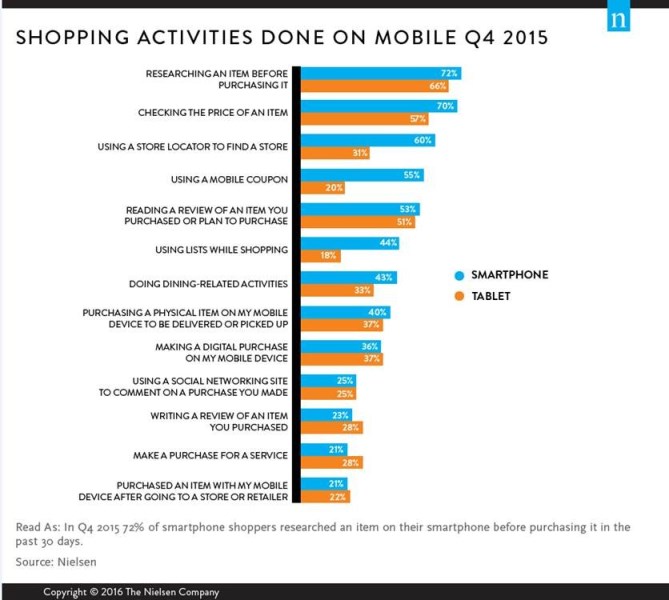Editor’s note: This is an edited version of an article that originally appeared on Nielsen Newswire and is being republished with permission from Nielsen, an information services company.
For many Americans, smartphones are as much a necessity in their daily lives as the air they breathe and the food they eat. These devices are constant companions, helping us take care of just about everything we need to do each day – watching our favorite shows and movies, keeping up with our friends, learning new languages and managing our finances.
And spending money is no exception!
In addition to growing as a new purchase channel, mobile commerce offers a plethora of opportunities for brands looking to reach their desired consumers. According to Nielsen’s fourth-quarter 2015 Mobile Wallet Report, 37 percent of respondents said their purchases start with mobile shopping more than one-quarter to half of the time. However, the competition is fierce, and in order to maximize these opportunities, marketers must know the best ways to position their products and communicate with appropriate audiences.
Consumers handle a lot of their shopping activities on their mobile devices, and everyone knows that savvy consumers do their due diligence before handing over their cash. In fact, 72 percent of smartphone shoppers research an item before purchasing it, 70 percent check the price of an item and 60 percent use a store locator to find a store where they can buy their desired product of choice.
While smartphones are used often in mobile shopping, tablets are also deployed. In fact, 66 percent of tablet shoppers researched an item before purchasing it, followed by 57 percent of tablet shopper checking the price of an item. Fifty-one percent of tablet shoppers read a review of an item they purchased or plan to purchase.

A visual experience
So which factors are most important to consumers when they’re shopping on mobile?
With mobile shopping being a visual experience, it should come as no surprise that consumers want to be able to see product pictures over everything else when shopping on a mobile phone (62 percent). Shoppers also want mobile-friendly versions of the Web sites they visit via mobile (48 percent), and 44 percent of respondents said that having the product descriptions was also highly important.

According to Nielsen’s Mobile Measurement, app usage is also accelerating when it comes to commerce and shopping. Notably, app usage increased 15 percent in time spent and unique audience year-over-year between fourth-quarter 2014 and fourth-quarter 2015.
After purchasing, consumers’ predominant shopper activity is tracking order progress (65 percent), followed by visiting a retailer site/app on their mobile device to browse and/or shop again (51 percent). And 33 percent of consumers say they use their smartphones to sign up for a rewards program after making a purchase on their smartphone.
Methodology
The insights from Nielsen’s English Language Mobile Wallet Report were gathered from a general population sample 18+ years old and consisted of 3,734 respondents identified through Nielsen Mobile Insights syndicated study who have used their smartphone or tablet for mobile shopping, paying or banking in the past 30 days.
App usage comes from Nielsen’s Electronic Mobile Measurement. There are approximately 9,000 smartphone panelists in the U.S. across both iOS and Android devices.
